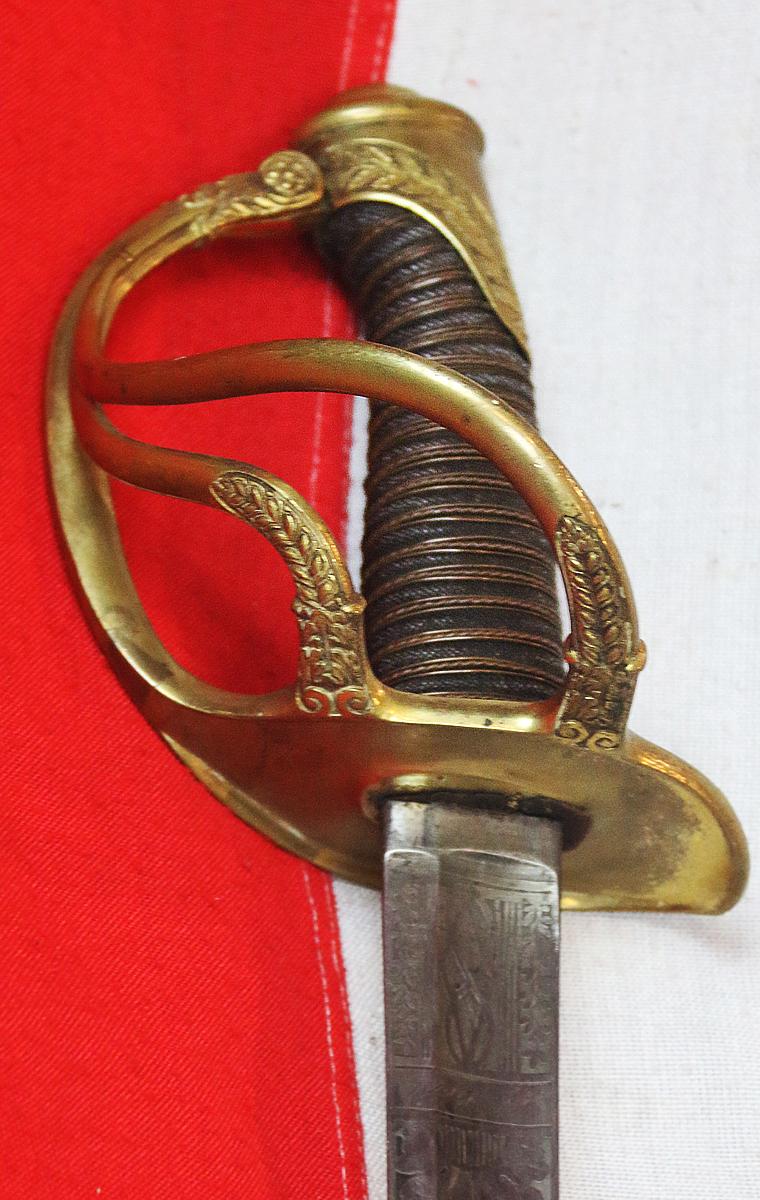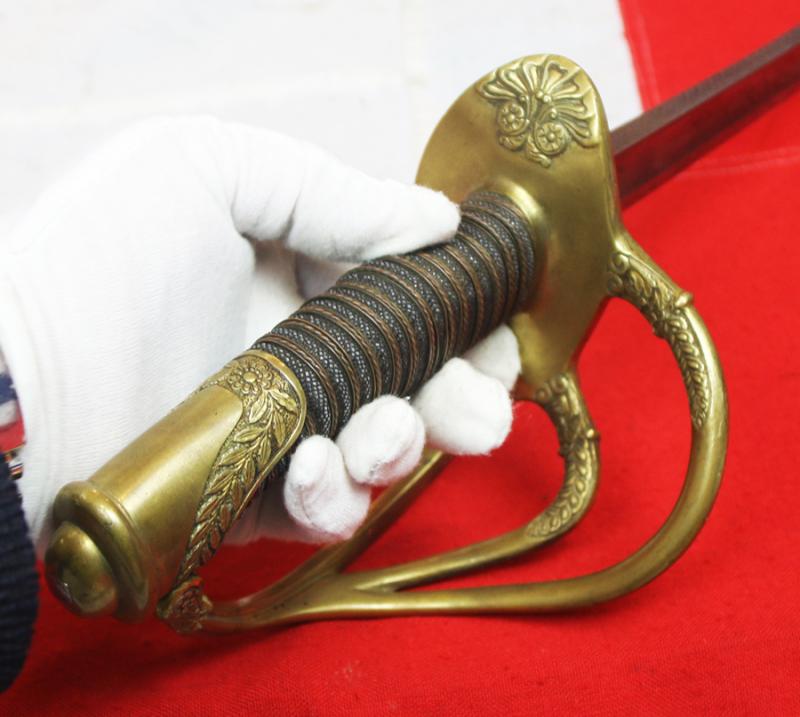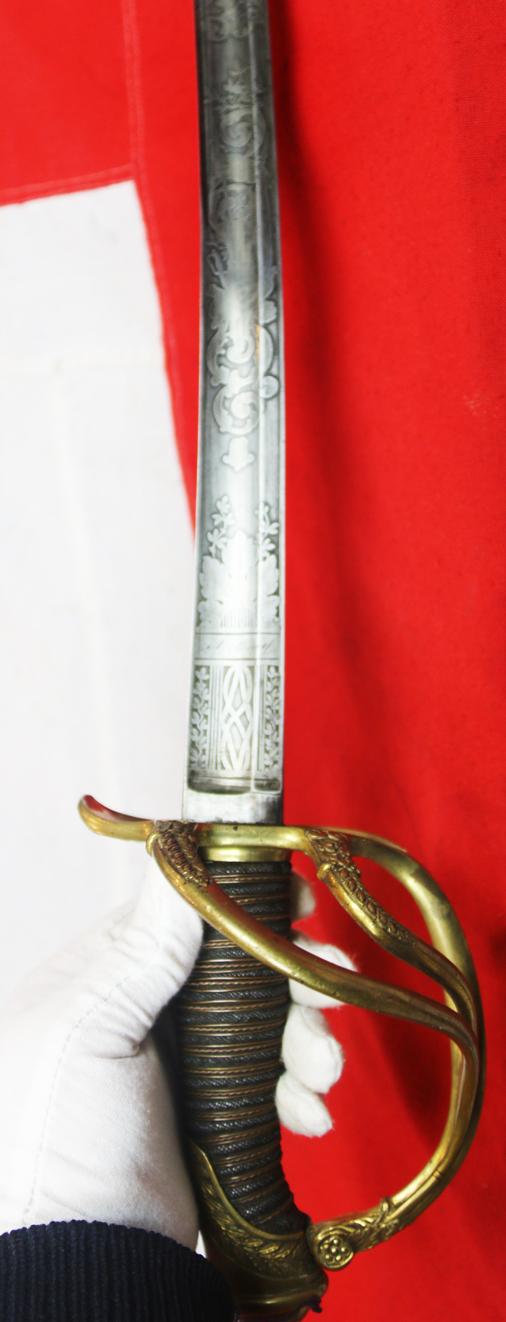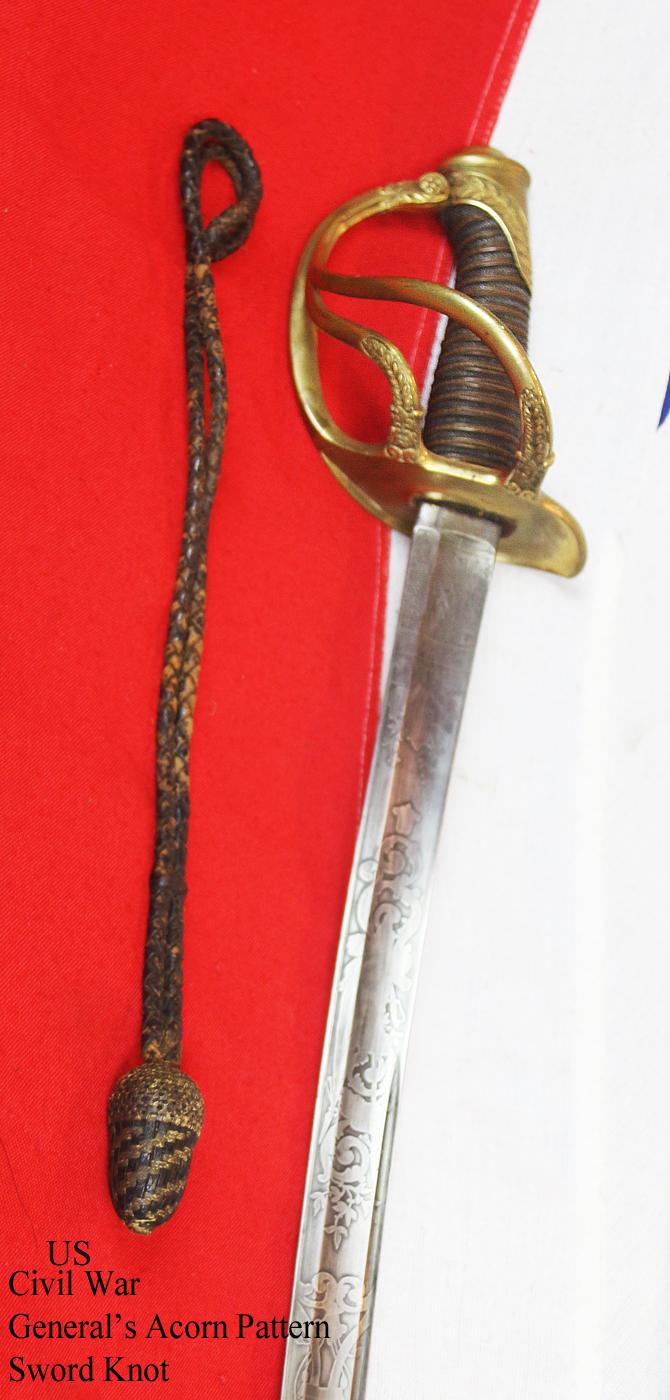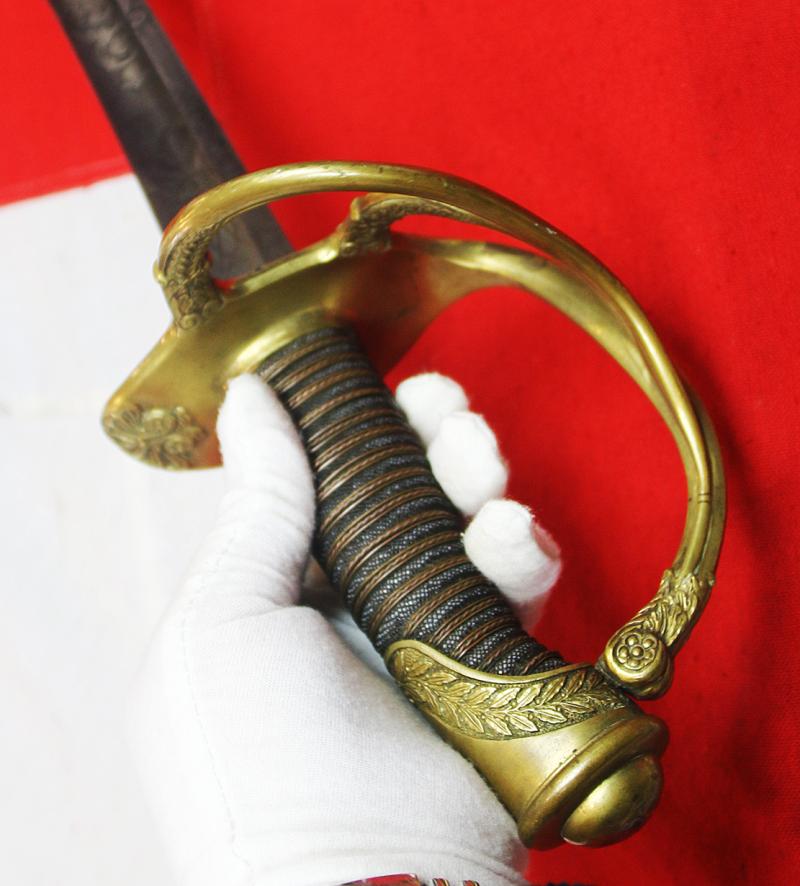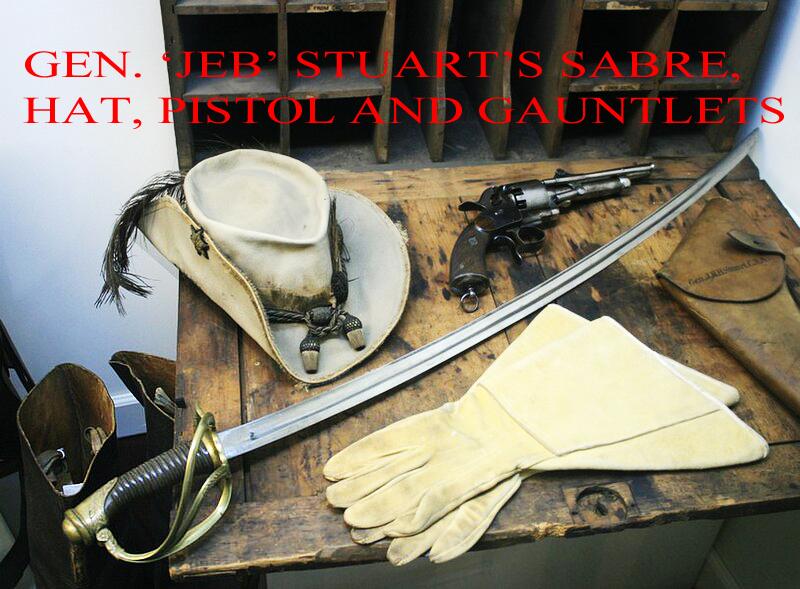A Fabulous & Rare US Civil War General's Sabre With Its Original Civil War General Officer's Pattern 'Acorn' Sword Knot, & Steel Combat Scabbard. Superb Deluxe Etched Blade
A near pair to three other Civil War General's swords, currently in American museums or in private ownership, of, General W.T.Sherman, Major General J.E.B. Stuart, and Lt General John Bell Hood. The sword knot is also a near pair to one {with its sword} of Civil War Brigadier General Champlin. We also show in the gallery General JEB Stuarts hat, that has a pair of interlinked Civil War General's pattern acorn sword knots around the brim. General Sherman's sword is currently offered at auction with a suggested price of $60,000
Our sword has superb quality elaborate hilt embellished decor for a general, and a stunning, deluxe etched blade with maker's name, and the original wirebound sharkskin grip. In its steel, blackened, combat scabbard. All in superb condition. the General’s knot is also in very good condition for age.
An American Civil War import, commissioned from either French or German swordsmiths, and interestingly, almost all the other General's swords within the various US museums were either commissioned in France or Germany, and not domestically produced.
One of the most famous Colonel’s of the Civil War was Robert Gould Shaw of the 54th Massachusetts Infantry Regiment. Robert Gould Shaw (1837-1863) carried his British import sword at the assault on Fort Wagner, Folly Island, S.C. on 18 July 1863. Where sadly he was KIA. The sword was a gift from his uncle George R. Russell, and in a letter to his father, dated 1 July 1863, Shaw acknowledges receiving “a box of Uncle George’s containing a beautiful English sword...” With sword in-hand, Colonel Shaw, of the 54th Massachusetts Infantry Regiment, was shot in the chest and killed while mounting the parapet of Ft. Wagner. The sword and other personal effects were taken from his body during the night and presumed lost. In June of 1865, the U.S. Colored Troops, under the command of Gen. Charles Jackson Paine, U.S.V., found the sword "in the possession of a rebel officer" near Goldsboro, N.C. The sword was returned to the Shaw family in 1865 by Capt. Solon A. Carter, U.S.V. but was misplaced after 1900 until it's recent discovery in 2017. That sword is now within the collections of the Massachuetts Historical Society, donated to them by the Shaw family.
James Ewell Brown "Jeb" Stuart (February 6, 1833 – May 12, 1864) was a Confederate States Army general during the American Civil War. He was known to his friends as "Jeb,” from the initials of his given names. Stuart was a cavalry commander known for his mastery of reconnaissance and the use of cavalry in support of offensive operations. While he cultivated a cavalier image (red-lined gray cape, the yellow waist sash of a regular cavalry officer, hat cocked to the side with an ostrich plume, red flower in his lapel, often sporting cologne), his serious work made him the trusted eyes and ears of Robert E. Lee's army and inspired Southern morale.3
Stuart graduated from West Point in 1854 and served in Texas and Kansas with the U.S. Army. Stuart was a veteran of the frontier conflicts with Native Americans and the violence of Bleeding Kansas, and he participated in the capture of John Brown at Harpers Ferry. He resigned his commission when his home state of Virginia seceded, to serve in the Confederate Army, first under Stonewall Jackson in the Shenandoah Valley, but then in increasingly important cavalry commands of the Army of Northern Virginia, playing a role in all of that army's campaigns until his death.
He established a reputation as an audacious cavalry commander and on two occasions (during the Peninsula Campaign and the Maryland Campaign) circumnavigated the Union Army of the Potomac, bringing fame to himself and embarrassment to the North. At the Battle of Chancellorsville, he distinguished himself as a temporary commander of the wounded Stonewall Jackson's infantry corps.
Stuart's most famous campaign, the Gettysburg Campaign, was flawed when his long separation from Lee's army left Lee unaware of Union troop movements so that Lee was surprised and almost trapped at the Battle of Gettysburg. Stuart received criticism from the Southern press as well as the proponents of the Lost Cause movement after the war. During the 1864 Overland Campaign, Union Maj. Gen. Philip Sheridan's cavalry launched an offensive to defeat Stuart, who was mortally wounded at the Battle of Yellow Tavern.
J.E.B Stuart’s sword was made in Paris. U.S. Army officers were responsible for providing their own side arms, so Stuart either ordered it himself or was given it as a gift. It now resides with his hat, in the American Civil War Museum
John Bell Hood (June 12 or June 29,3 1831 – August 30, 1879) was a Confederate general during the American Civil War. Hood's impetuosity led to high losses among his troops as he moved up in rank. Bruce Catton wrote that "the decision to replace Johnston with Hood was probably the single largest mistake that either government made during the war." Hood's education at the United States Military Academy led to a career as a junior officer in the infantry and cavalry of the antebellum U.S. Army in California and Texas. At the start of the Civil War, he offered his services to his adopted state of Texas. He achieved his reputation for aggressive leadership as a brigade commander in the army of Robert E. Lee during the Seven Days Battles in 1862, after which he was promoted to division command. He led a division under James Longstreet in the campaigns of 1862–63. At the Battle of Gettysburg, he was severely wounded, rendering his left arm mostly useless for the rest of his life.4 Transferred with many of Longstreet's troops to the Western Theater, Hood led a massive assault into a gap in the U.S. line at the Battle of Chickamauga but was wounded again, requiring the amputation of his right leg.
Hood returned to field service during the Atlanta Campaign of 1864 and, at the age of 33, was promoted to temporary full general and command of the Army of Tennessee at the outskirts of Atlanta, making him the youngest soldier on either side of the war to be given command of an army. There, he dissipated his army in a series of unsuccessful assaults and was forced to evacuate the besieged city. Leading his men through Alabama and into Tennessee, his army was severely damaged in a massive frontal assault at the Battle of Franklin. The Battle of Franklin was fought on November 30, 1864 in Franklin, Tennessee; in Williamson County. John Bell Hood's Army of Tennessee (around 33,000 men) faced off with John M. Schofield's Army of the Ohio and the Cumberland (around 30,000 men). Often cited as "the bloodiest five hours" during the American Civil War, the Confederates lost between 6,500 - 7,500 men, with 1,750 dead. The Federals lost around 2,000 - 2,500 men, with just 250 or less killed. Hood lost 30,000 men in just six months (from July 1864 until December 15). The Battle of Franklin was fought mostly at night. Several Confederate Generals were killed, including Patrick Cleburne, and the Rebels also lost 50% of their field commanders. Hood would limp into Nashville two weeks later before suffering his final defeat before retreating to Pulaski in mid December. Hundreds of wounded Confederate soldiers were taken to the John and Carrie McGavock home - Carnton - after the battle. She became known as the Widow of the South. The McGavock's eventually donated two acres to inter the Confederate dead. Almost 1,500 Rebel soldiers are buried in McGavock Confederate Cemetery, just in view of the Carnton house.
Hood’s sword was purchased from Coulaux & Cie, Klingenthal, France. Lt. Gen. John Bell Hood used his cavalry saber during his service in the Confederate Army. It now resides in the Museum of the Confederacy in Richmond Va. Hood also had another sword an infantry Militia pattern dress sword, imported from Germany made by P.D.Lunschloss & Companie, that now resides in the American Civil War Museum.
Sadly, we do not know the name of the general officer to whom our sabre once originally belonged.
Code: 25224
8995.00 GBP


